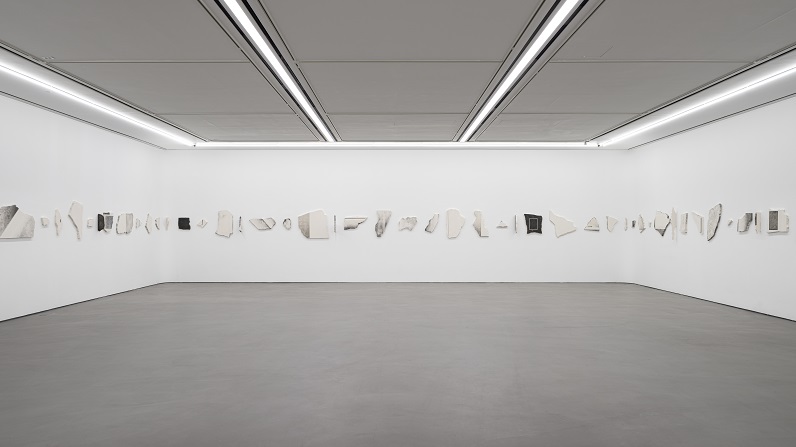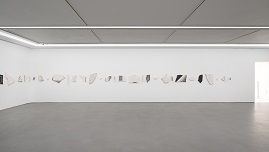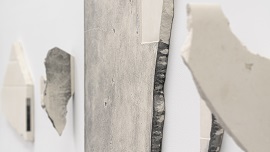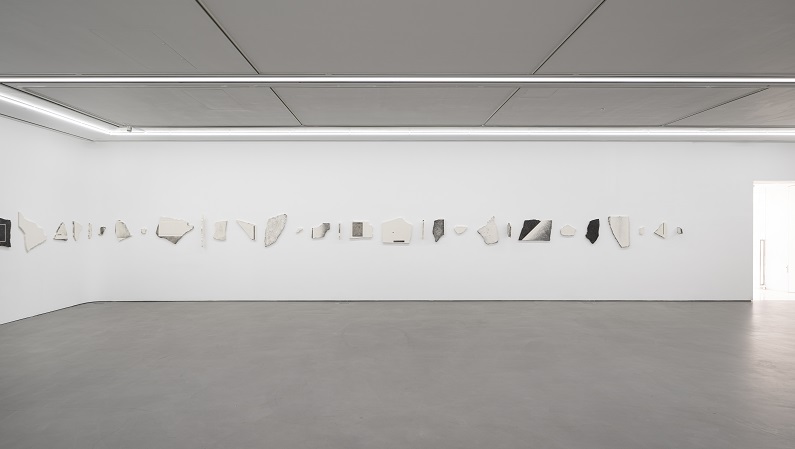- Artist Hyun Bhin Kwon

Installation view
Photo by Jeong Kyun Goh
Tuesday-Saturday 11:00~19:00 / Closed on Sunday, Monday
DOOSAN Gallery: 15, Jongno 33-gil, Jongno-gu, Seoul, Korea
Tel. 02-708-5050
Hyun Bhin Kwon’s solo exhibition, We Go, envisages movements of objects that have seemingly come to an end. In the title, “we” encompasses the various subjects that a sculpture involves, and “go” represents the many kinds of movements that a sculpture necessitates. Identifying these often requires a few shifts in timeline and adjustments in spatial distance.
Kwon regards her sculptures as traces of time—that the past, present, and future of a material culminate in the sculptures. Working primarily with stone, she tracks down the weakest spot. She observes it for a long time, discovers the very spot where the stone willingly cracks open, then taps, carves, and conjoins the pieces. The lines, planes, and colors on the stone sculptures might suggest intent, but they are closer to traces of Kwon’s time spent with the material. To Kwon, the act of “sculpting” a stone with interlocking layers of time is less a means to an end but a continued signal of what is to come, a state of constantly reducing and cracking open.
Is it ever possible to understand the time a stone embodies? An object that seems like a condensation of eternity? By virtue of the artist, the stone halts its movement and assumes a form. Shattered fragments allude to its whole, and a broken line points to a corner it seeks to complete. Black ink bears the abyss that absorbs all light and color. Nevertheless, the stone, by nature, refuses to be moored, lessening the pigment’s vibrancy that strove to penetrate even further or crumbling to even smaller pieces. It reminds us that, as a part of nature, its clock is yet to stand still.
When these stone sculptures are introduced to the exhibition space, the definition of “subject” extends to include those experiencing the sculptures. If experiencing a painting can be seen as observing a surface and engaging in an illusion, then experiencing a sculpture is akin to journeying from one surface to the next and tiling them together to envision a form. Hence, such experience results in movement, as it requires the subject to physically navigate around the work. The flat sculptures on the wall might appear to be abstract paintings on shaped canvases, but their depth is not quite the indicator of what they are. What is crucial is the fact that they are fragments broken off of a larger whole. The procession of wall-hanging pieces is, therefore, like a blueprint that lays out the numerous facets of a whole—the original sculpture or span of time.
The task of the viewer is to reassemble these pieces and trace back their previous forms and times. To stitch these times together, the viewer must stand in the center of the space and piece the surrounding sculptures into a connected narrative or step closer to the sculptures and search for hints of an unfinished story. When the movement of the artist and the movement of the viewer interact, the “sculptural experience” at that moment, is when scattered subjects fall into line and separate spacetimes come into contact.
Hyun Bhin Kwon (b. 1991) lives and works in Paju, KR. Kwon was selected to participate in DOOSAN Art Lab Exhibition 2019: Part 1 (2019, DOOSAN Gallery, Seoul, KR) and had solo exhibitions at spaces including Gallery Kiche (2021, Seoul, KR), Monoha (2020, Seoul, KR), A-Lounge (2019, Seoul, KR), and RAINBOWCUBE (2018, Seoul, kR). Kwon has also shown in group exhibitions at the HITE Collection (2022, Seoul, KR), WESS (2022, Seoul, KR), Art Sonje Center (2021, Seoul, KR), Amado Art Space (2021, Seoul, KR), and P21 (2020, Seoul, KR).
Curated by Jinyoung You │ Assisted by Seongeun Park
































